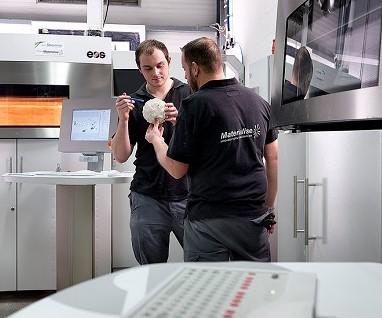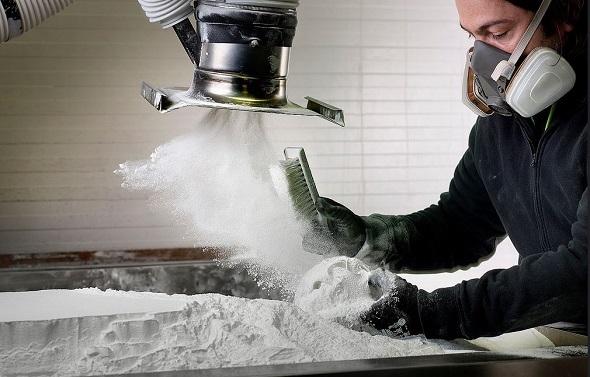 You have been working hard for a while on that new 3D design, and you can’t wait to see it printed. But you better exercise patience, because sometimes 3D printing production takes time. Sure, the actual print itself may not take that much time, but much more goes into a high-quality print than just the printing. As i.materialise reminds us, a high-quality 3D print also requires “checking, planning, printing, cleaning, finishing, quality checking, and packing your object.” There’s plenty involved in the 3D printing production process, which explains why sometimes you have to wait for a week or more to receive your much anticipated prints.
You have been working hard for a while on that new 3D design, and you can’t wait to see it printed. But you better exercise patience, because sometimes 3D printing production takes time. Sure, the actual print itself may not take that much time, but much more goes into a high-quality print than just the printing. As i.materialise reminds us, a high-quality 3D print also requires “checking, planning, printing, cleaning, finishing, quality checking, and packing your object.” There’s plenty involved in the 3D printing production process, which explains why sometimes you have to wait for a week or more to receive your much anticipated prints.
 According to i.materialise, sometimes plastic polyamide prints can take up to 6 days, with resin taking longer (between 8 and 13 days) and silver taking as long as 8-15 days. (For the exact production times expected with every material offered by i.materialise, go here.) Is there a way to get quicker prints without sacrificing quality? i.materialise’s solution to the problem of slow 3D printing production time is to create a “fast lane.” For smaller polyamide prints, it is now possible to get them within 2 days, as long as finishing options, such as dyeing and polishing, are not required. This process, known as the “Polyamide Priority,” is an option for people who have simpler designs that do not require all of the extra time that other prints do.
According to i.materialise, sometimes plastic polyamide prints can take up to 6 days, with resin taking longer (between 8 and 13 days) and silver taking as long as 8-15 days. (For the exact production times expected with every material offered by i.materialise, go here.) Is there a way to get quicker prints without sacrificing quality? i.materialise’s solution to the problem of slow 3D printing production time is to create a “fast lane.” For smaller polyamide prints, it is now possible to get them within 2 days, as long as finishing options, such as dyeing and polishing, are not required. This process, known as the “Polyamide Priority,” is an option for people who have simpler designs that do not require all of the extra time that other prints do.
What goes on behind the scenes of 3D printing production? First, you upload your 3D file and choose the material you want it printed in. Then, i.materialise determines if it’s printable and plans the printing build. Since the company receives many prints at once, it has to plan how it will print many models together at one time. For that, Magics software is used to place models in a three-dimensional space, “nesting” them together. Then printing can commence once the size, technology, and volume of the build are determined. There’s also a mandatory post-printing cool down period that can take up to 2 days. The exact post-production steps depend greatly on the material being used, too.
i.materialise explains how materials differ in post-print production:
“Polyamide 3D prints are dug out of the un-sintered powder and cleaned with high-pressure air guns. Support structures for resin 3D prints need to be cut away, ceramic prints need to go into an oven, multicolor prints need to be superglued, silver prints need to be taken out of their mold.”
Over 100 different finishing options (such as dyeing, polishing, gold-plating, and coating) are offered by i.materialise, and these require more time. And last but not least in the production process, a final quality check is performed and your order is packaged and shipped.
Polyamide Priority prints, which require no finishing, are guaranteed within 48 hours by i.materialise. And as for prints in other materials, now we know a little bit more about why these take longer. Discuss this story in the 3D Printing Production Speed forum thread on 3DPB.com.
Subscribe to Our Email Newsletter
Stay up-to-date on all the latest news from the 3D printing industry and receive information and offers from third party vendors.
You May Also Like
3D Printing Unpeeled: New Arkema Material for HP, Saddle and Macro MEMS
A new Arkema material for MJF is said to reduce costs per part by up to 25% and have an 85% reusability ratio. HP 3D HR PA 12 S has been...
3D Printing News Briefs, January 20, 2024: FDM, LPBF, Underwater 3D Printer, Racing, & More
We’re starting off with a process certification in today’s 3D Printing News Briefs, and then moving on to research about solute trapping, laser powder bed fusion, and then moving on...
3D Printing Webinar and Event Roundup: December 3, 2023
We’ve got plenty of events and webinars coming up for you this week! Quickparts is having a Manufacturing Roadshow, America Makes is holding a Member Town Hall, Stratafest makes two...
Formnext 2023 Day Three: Slam Dunk
I’m high—high on trade show. I’ve met numerous new faces and reconnected with old friends, creating an absolutely wonderful atmosphere. The excitement is palpable over several emerging developments. The high...
































